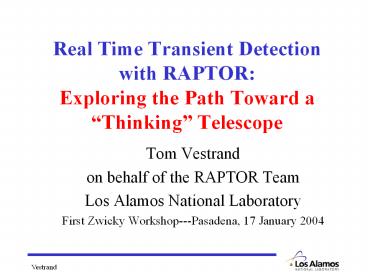Real Time Transient Detection with RAPTOR: Exploring the Path Toward a
Title:
Real Time Transient Detection with RAPTOR: Exploring the Path Toward a
Description:
Hot Pixels. Satellites. Airplanes. Cosmic Rays. Glints from Space Junk. Image Defects ... ( like the rod cells of the retina ) ... –
Number of Views:71
Avg rating:3.0/5.0
Title: Real Time Transient Detection with RAPTOR: Exploring the Path Toward a
1
Real Time Transient Detectionwith RAPTOR
Exploring the Path Toward a Thinking Telescope
- Tom Vestrand
- on behalf of the RAPTOR Team
- Los Alamos National Laboratory
- First Zwicky Workshop---Pasadena, 17 January 2004
2
Scientific Motivation Searching for Optical
Transients in Real Time
- The optical sky, even for relatively bright
transient objects, is largely unmonitored. - There are spectacular Explosive Optical
Transients that have been found because of High
Energy Satellite real-time alerts. - But fast Optical Transients may exist that cannot
be found by high-energy satellite monitoring,
either because they are precursors of or are
unrelated to high-energy transients.
3
(No Transcript)
4
- Mining in real time is the ability to recognize,
gather, and analyze observations as a transient
event is in progress---thereby enabling more
detailed follow-up observations while the event
is on-going.
5
Why is the Problem Hard?
- Need a Fast Pipeline that makes photometric
measurements of more than 100,000 sources and
identifies transients in less than 30 seconds.
(10 times faster than the fastest real-time
pipeline.) - Must move the more sensitive narrow-field
telescopes into the transient in seconds for
spectroscopy and light curve measurement. (mounts
must move 10 times faster than typical
astronomical mounts) - Must correctly identify, in real time, the
celestial transient in the forest of
non-celestial transients. ( more than 1000 false
positives for every real event)
6
False Positives
- Hot Pixels
- Satellites
- Airplanes
- Cosmic Rays
- Glints from Space Junk
- Image Defects
- False positives killed the efforts by the
MIT/GODDARD team with the ETC (Explosive
Transient Camera) in the early 1990s.
7
Human VisionA Closed Loop Real Time System
- Wide-field, low resolution imaging by rods cells
of retina - Narrower field, higher spatial resolution imaging
by cone cells of fovea---yields color information - Binocular vision---for distance information and
correction of image defects - Processor running complex real time
software---the brain - Eyes are rapidly slewing to quickly point the
fovea for follow-up observations - Brain has an adaptive catalog---our memory
8
Raptor Sky Monitoring with Both Eyes Open
- Wide-field imaging system monitors 1300
square-deg with resolution 35 arcsec and
limiting magnitude of R13th in 60 seconds. (
like the rod cells of the retina ) - Each array has a fovea telescope with
limiting magnitude of R16.5 (60 sec),
resolution of 7 arcsec and Gunn g (or r) filter.
Provides color, better resolution, and faster
cadence light curves (cone cells of fovea) - Rapidly slewing mount places the fovea anywhere
in the field in lt3 seconds. (rapid eye movement). - Two identical arrays are separated by 38 km.
(stereoscopic vision)
9
Prompt Optical Emission from a Below Average
Gamma Ray Burst
10
Simultaneous Two Color Measurements during the
first minute
- Color measurements? slope of continuum, that plus
time evolution yields basic parameters of flow
the Lorentz factor, the ambient density, the
fraction of the energy in mass of the particles,
and the fraction of the energy in the magnetic
field
11
GRB Precursors, Short Duration GRBs, and the
First Few Seconds
- Are there optical precursor flashes to GRBs?
- Do short duration GRBs generate prompt optical
emission? - What happens in the first few seconds of a long
duration GRB? - These important questions cannot be answered by
any rapidly slewing telescope.
12
The Solution Wide-Field Stereoscopic Monitoring
- RAPTOR continuously monitors essentially all of
the field-of-view (FOV)of the Swift burst alert
telescope. (gt1000 times the FOV of typical wide
field telescope.) - RAPTOR has the capability to find GRB precursors,
prompt emission from short Duration GRBs and
observe the first few seconds of long GRBs.
13
Current Status
- Full stereoscopic closed loop operation is now
operating. - Stereoscopic viewing reduces the number of false
positives from more than a thousand per night to
less than a few per night.
14
Moving Toward a Thinking System
- Goal is to build a system that not only
recognizes transients, but also recognizes
important anomalies in persistent objects and
performs prompt follow-up observations in real
time. - To do this, we need--
- A record of the variability of sky that is
continuously updated to place the observed
variation in context. - Machine Learning and Data Mining tools able to
find and recognize the important variations in
the flood of incoming measurements.
15
http//skydot.lanl.gov
16
Public SkyDOT website
skydot.lanl.gov
17
(No Transcript)
18
(No Transcript)
19
Conclusions
- Time Domain Astronomy is too important to be
left to the Astronomers. - To be effective it requires real-time follow-up
observations. - We do not have the attention span, response
time, or memory required to monitor the huge
volume of data, recognize important variations,
and respond. - Autonomous Robotic Telescopes with smarts and
the ability to learn will be essential for
exploring the Time Domain in astronomy.































